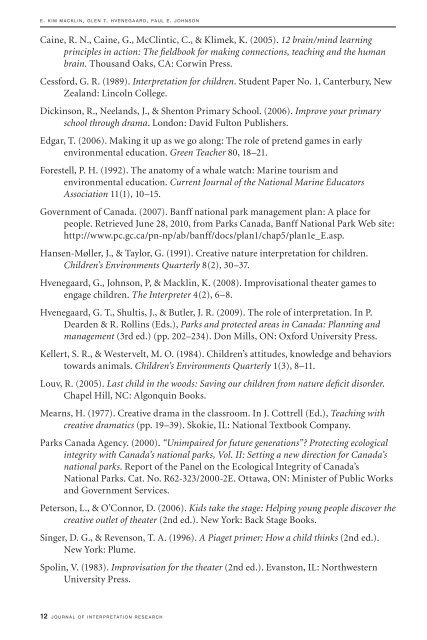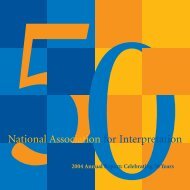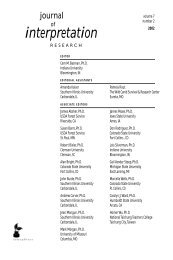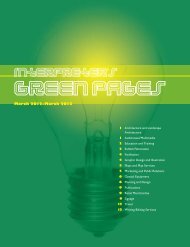interpretation
Volume 15, Number 1 - National Association for Interpretation
Volume 15, Number 1 - National Association for Interpretation
You also want an ePaper? Increase the reach of your titles
YUMPU automatically turns print PDFs into web optimized ePapers that Google loves.
e. k i m m a c k l i n , g l e n t. h v e n e g a a r d , p a u l e. j o h n s o n<br />
Caine, R. N., Caine, G., McClintic, C., & Klimek, K. (2005). 12 brain/mind learning<br />
principles in action: The fieldbook for making connections, teaching and the human<br />
brain. Thousand Oaks, CA: Corwin Press.<br />
Cessford, G. R. (1989). Interpretation for children. Student Paper No. 1, Canterbury, New<br />
Zealand: Lincoln College.<br />
Dickinson, R., Neelands, J., & Shenton Primary School. (2006). Improve your primary<br />
school through drama. London: David Fulton Publishers.<br />
Edgar, T. (2006). Making it up as we go along: The role of pretend games in early<br />
environmental education. Green Teacher 80, 18–21.<br />
Forestell, P. H. (1992). The anatomy of a whale watch: Marine tourism and<br />
environmental education. Current Journal of the National Marine Educators<br />
Association 11(1), 10–15.<br />
Government of Canada. (2007). Banff national park management plan: A place for<br />
people. Retrieved June 28, 2010, from Parks Canada, Banff National Park Web site:<br />
http://www.pc.gc.ca/pn-np/ab/banff/docs/plan1/chap5/plan1e_E.asp.<br />
Hansen-Møller, J., & Taylor, G. (1991). Creative nature <strong>interpretation</strong> for children.<br />
Children’s Environments Quarterly 8(2), 30–37.<br />
Hvenegaard, G., Johnson, P, & Macklin, K. (2008). Improvisational theater games to<br />
engage children. The Interpreter 4(2), 6–8.<br />
Hvenegaard, G. T., Shultis, J., & Butler, J. R. (2009). The role of <strong>interpretation</strong>. In P.<br />
Dearden & R. Rollins (Eds.), Parks and protected areas in Canada: Planning and<br />
management (3rd ed.) (pp. 202–234). Don Mills, ON: Oxford University Press.<br />
Kellert, S. R., & Westervelt, M. O. (1984). Children’s attitudes, knowledge and behaviors<br />
towards animals. Children’s Environments Quarterly 1(3), 8–11.<br />
Louv, R. (2005). Last child in the woods: Saving our children from nature deficit disorder.<br />
Chapel Hill, NC: Algonquin Books.<br />
Mearns, H. (1977). Creative drama in the classroom. In J. Cottrell (Ed.), Teaching with<br />
creative dramatics (pp. 19–39). Skokie, IL: National Textbook Company.<br />
Parks Canada Agency. (2000). “Unimpaired for future generations”? Protecting ecological<br />
integrity with Canada’s national parks, Vol. II: Setting a new direction for Canada’s<br />
national parks. Report of the Panel on the Ecological Integrity of Canada’s<br />
National Parks. Cat. No. R62-323/2000-2E. Ottawa, ON: Minister of Public Works<br />
and Government Services.<br />
Peterson, L., & O’Connor, D. (2006). Kids take the stage: Helping young people discover the<br />
creative outlet of theater (2nd ed.). New York: Back Stage Books.<br />
Singer, D. G., & Revenson, T. A. (1996). A Piaget primer: How a child thinks (2nd ed.).<br />
New York: Plume.<br />
Spolin, V. (1983). Improvisation for the theater (2nd ed.). Evanston, IL: Northwestern<br />
University Press.<br />
12 j o u r n a l o f i n t e r p r e t a t i o n r e s e a r c h












